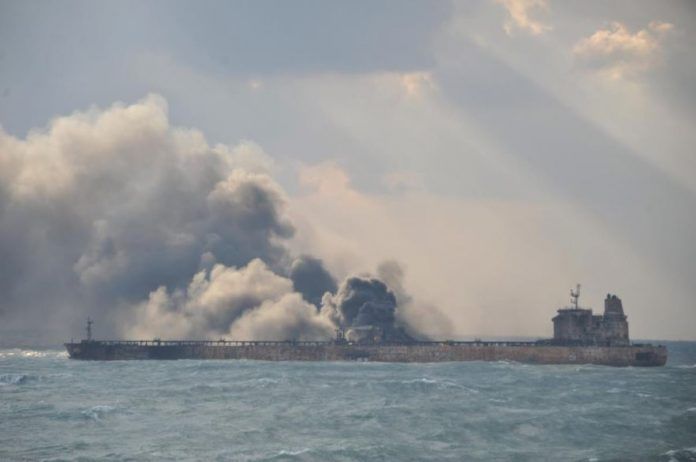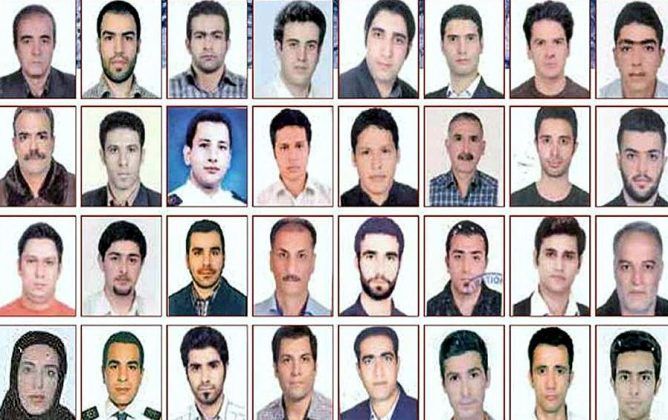
On January 6, an Iranian tanker, Sanchi, carrying 136,000 tonnes of light oil, collided with a Hong Kong-registered bulk freighter, CF Crystal, off the coast of China. The tanker burst into flames eight days after the collision and sank. The missing crew, 32 Iranians, and two Bangladeshis are presumed dead. Only three bodies have been recovered so far. The Sanchi was headed to South Korea to deliver its cargo. Chinese officials have played down the fears of a major environmental disaster.
During a closed-door session of the Majlis [Iranian Parliament] on January 15, deputies discussed a top-secret memo which claimed that a U.S. missile had sunk the tanker. Some people have speculated that the tanker was actually carrying oil to North Korea. To avoid being tracked, it had reportedly dropped off the radar near Shanghai, shut down power and stopped all communication. But all attempts to sail undetected had apparently failed. It is even suggested that the U.S. Navy had made repeated attempts to warn the tanker. And only after failing to receive any response from the captain of the Sanchi, a U.S. Navy ship or aircraft had attacked the tanker and sunk it. There are also rumors that it was the Chinese who fired on the tanker.
While a number of conspiracy theories have been circulating on social media, it is clear that many questions regarding the collision remain unanswered. It is unclear why there are no photographs of the Hong Kong-registered cargo ship that collided with the Sanchi. There hasn’t been much information about efforts, if any, to rescue the crew of the CF Crystal.
There is some speculation that not all 32 crew members were in the engine room, unlike what has been reported. Some of them had to be on deck with the captain about 80 meters from where the explosion occurred. It took three days for the fire to reach the main cabin. It is, therefore, hard to believe that during that time, some crew members should have failed to escape the burning tanker using inflatable life jackets and lifeboats. The Chinese authorities have, so far, refused to release the tanker’s black box to Panama, where the ship was officially registered.
Majid Akhavan, a correspondent for the Iranian state-TV [IRIB] based in Turkey, posted comments on his Instagram page by industry experts who cast doubts on the official explanation for the collision.
“In my view and that of other experts I’ve spoken to, it would have been unlikely for all of the crew members to have been in the engine room at the same time. That would have been against maritime safety regulations. The crew’s first and foremost responsibility would have been to fight the fire and start the evacuation. The safety guidelines do not require the crew to take shelter in the engine room or any other place on the ship. The crew members would lock themselves in the engine room only if the tanker is attacked by pirates. No captain ever asks his crew to move to the lowest compartment of the tanker during a fire. He usually orders all hands to put on life jackets and use lifeboats to save themselves. There are normally two lifeboats, five inflatable boats, 14 lifebuoys, life jackets and floating swimsuits on a tanker the size of Sanchi,” Akhavan reported, quoting a naval engineer.
Engineer “A,” an employee of the maritime fleet of the Islamic Republic of Iran Shipping Line [IRISL], told Kayhan London: “The tanker had burned down in the first few hours. According to its cargo manifest and bill of lading, the tanker was transporting oil to South Korea.”
He added: “There are a number of issues that need to be highlighted here. Due to international sanctions, the tanker’s real cargo was not insured. It also lacked the required equipment to deal with the damaged caused by the collision. The tanker was insured. However, to circumvent U.S. sanctions and pay a lower shipping insurance fee, a cheaper and less flammable oil product was listed on the cargo manifest, instead of the lighter and highly combustible Butanol fuel that Sanchi was carrying.”
When asked if the accident could have been prevented, Mr. A. said: “I work closely with technical experts and ship captains. I’ve discussed this incident with many of them, who believe that certain measures could have been taken, but only in the first 30 minutes immediately after the collision. After that, fire, high temperatures, and toxic fumes would have made any operation very difficult. Sanchi had the right of way. So it is unclear why the CF Crystal had not stopped and continued on a collision course with the tanker.” He added: “The IRISL had started an insurance claim proceeding already.”
Meanwhile, foreign sources have claimed that Sanchi suspended all radar and radio communications hours before the collision. There is no shortage of theories about the cause of this tragic incident. The families of the dead crewmen blame the Islamic Republic and the Chinese government for failing to save the lives of their loved ones.




See ! You journalists, so unfair, really. You should never ask us :Why this? why that ? In Iran.We don’t give a hoot.Not a drop in the bucket .We stopped asking questions a long time ago. Do you remember the night our hellish 13th Imam walked in to the moon ,like a rattle snake ?Did we ask him what the hell are you doing up there? Why so angry, foaming at the mouth ,huffy,WHY? No! We did not. Did we ask when # 14th,this one, changing the direction, howling at the moon, came , why this rabid dog? No we didn’t. We all knew he is a fraud , a theif,lunatic,crazy, a Russian agent, an opium addicted ,simply a monster S O B ,did we ask :why this one? No, not a word ,not a slang and now you have waken me up in the middle of the night, with your funny question, simply ,GOOD NIGHT DEAR